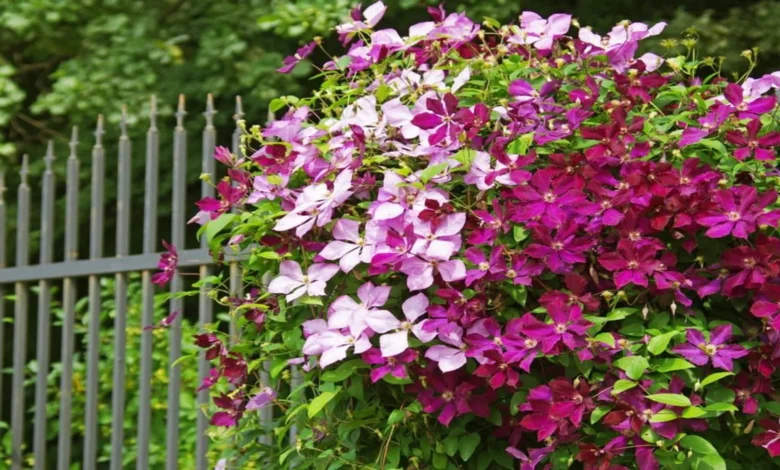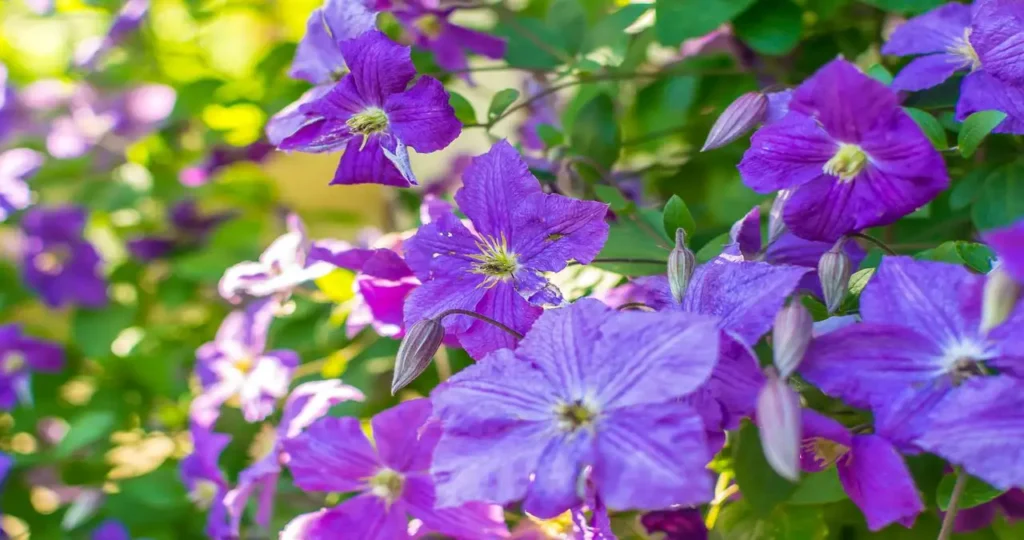Title: Clematis Will Goodwin: A Detailed Guide to Cultivating this Stunning Climber

Introduction
Clematis Will Goodwin is one of the most admired cultivars in the world of gardening. With its vibrant blue flowers and graceful vines, it’s the perfect plant to brighten up any garden. Whether you’re a seasoned gardener or a beginner, learning about Clematis Will Goodwin can add a new layer of beauty to your garden landscape. This guide will provide you with all the essential information you need to successfully grow and care for this remarkable climbing plant.
What is Clematis Will Goodwin?
Clematis Will Goodwin is a deciduous climbing plant, known for its captivating sky-blue flowers that bloom profusely in late spring to early summer. Named after Will Goodwin, a noted English horticulturist, this clematis variety belongs to the large-flowered group of clematis and is a hybrid bred for its beauty and hardiness.
The plant’s striking flowers are not only showy but also come in a delicate, soft shade of blue, which is rare among clematis varieties. This makes Clematis Will Goodwin an excellent choice for gardeners who are looking to add color and charm to fences, trellises, or pergolas.
How to Grow Clematis Will Goodwin
Growing Clematis Will Goodwin in your garden is relatively straightforward, provided you understand the plant’s needs. Here’s a closer look at how to successfully grow this stunning climber:
Choosing the Right Location
Clematis Will Goodwin thrives in locations where it can get plenty of sunlight. Ideally, choose a spot that receives at least six hours of sunlight each day. However, the roots of Clematis Will Goodwin prefer some shade, so it’s best to plant it in a place where the roots are shaded while the top of the plant enjoys sunlight.
If you’re planting Clematis Will Goodwin along a wall or trellis, be sure that the plant has enough space to spread out. These plants grow vigorously and require support as they climb.
Soil Requirements
For optimal growth, Clematis Will Goodwin needs well-draining soil that is rich in organic matter. You can improve the soil’s fertility by mixing compost into the planting area. The soil should be slightly acidic to neutral, with a pH level between 6.0 and 7.0. Proper drainage is crucial, as waterlogged soil can lead to root rot.
Planting Clematis Will Goodwin
Planting Clematis Will Goodwin requires a bit of care, but the results are well worth the effort. The best time to plant this clematis is in early spring or late fall when the weather is cooler.
Preparing the Planting Hole
Dig a hole that is about twice the size of the root ball of your clematis. This will give the roots plenty of room to spread out. If you’re planting several clematis vines, make sure to space them about 3 to 4 feet apart to allow for their growth.
Before planting, add some well-rotted compost or organic matter to the bottom of the hole to ensure good drainage and fertility. It’s also a good idea to sprinkle a slow-release fertilizer in the hole to give your plant a healthy start.
Planting Process
Place the root ball into the hole, ensuring that the top of the root is about 2 inches below the soil surface. This planting depth helps protect the roots from extreme heat and cold. Gently fill the hole with soil, pressing down slightly to eliminate air pockets. Water thoroughly after planting to help the plant settle in.
Pruning Clematis Will Goodwin
Pruning is an essential aspect of caring for Clematis Will Goodwin, as it helps to keep the plant healthy and encourages abundant flowering. Pruning should be done in early spring before new growth begins.
When to Prune
Since Clematis Will Goodwin is a part of the Group 2 pruning category, it flowers on both old and new wood. This means you should prune it lightly in the spring, removing any dead or damaged stems and cutting back any older growth to just above a pair of healthy buds. This will encourage fresh new shoots, which will produce beautiful flowers.
How to Prune
Use clean, sharp pruning shears to cut back the plant, being careful not to damage the stems. After the initial pruning in spring, you can also remove any dead flowers after they’ve finished blooming. This helps the plant focus energy on producing new flowers.
Fertilizing Clematis Will Goodwin
To promote healthy growth and vibrant blooms, fertilizing your Clematis Will Goodwin is important. Clematis plants are heavy feeders, and providing them with the right nutrients can make a significant difference in their performance.
Types of Fertilizers to Use
For Clematis Will Goodwin, a balanced fertilizer works best. Choose one that has an equal ratio of nitrogen, phosphorus, and potassium (such as 10-10-10). In early spring, apply a slow-release granular fertilizer to the soil around the base of the plant. In addition, you can use liquid fertilizers throughout the growing season to give your plant a quick nutrient boost.
Frequency of Fertilization
Fertilize your Clematis Will Goodwin once in early spring and then again after the first flush of blooms. Avoid fertilizing late in the season, as this can encourage new growth that may be damaged by frost in the fall.
Watering Clematis Will Goodwin
Like all clematis varieties, Will Goodwin needs consistent watering, especially during the growing season. However, the plant doesn’t like to sit in soggy soil, so proper drainage is critical.
How Often to Water
Water your Clematis Will Goodwin deeply once a week during dry spells, ensuring that the soil is moist but not waterlogged. If you live in an area with heavy rainfall, you may not need to water as frequently. Always check the soil moisture before watering to avoid over-watering.
Common Pests and Diseases Affecting Clematis Will Goodwin
Clematis Will Goodwin is generally a hardy plant, but like all plants, it can be susceptible to certain pests and diseases. Being aware of these issues can help you catch problems early and keep your clematis thriving.
Pests
One of the most common pests that affect Clematis Will Goodwin is aphids. These tiny insects can suck the sap from the leaves, causing the plant to become weak and stunted. To control aphids, you can simply spray the plant with a strong stream of water or use insecticidal soap.
Diseases
Clematis Will Goodwin can also be susceptible to fungal diseases such as powdery mildew, especially in humid climates. Regularly check the plant for any signs of powdery white growth on the leaves. If you spot any, treat the plant with a fungicide to control the spread.
Propagating Clematis Will Goodwin
If you want to grow more Clematis Will Goodwin vines, propagation is an option. There are several methods to propagate this plant, including stem cuttings and layering.
Stem Cuttings
In late summer, take a healthy, non-flowering stem and cut it into 4 to 6-inch sections. Remove the lower leaves and dip the cut end in the rooting hormone. Plant the cutting in a pot with well-draining soil and keep it in a humid environment. After a few weeks, the cutting should develop roots and be ready to transplant into the garden.
Layering
Layering is another easy way to propagate Clematis Will Goodwin. Simply bend a low-growing stem to the ground and bury a section of it in the soil, leaving the tip exposed. The buried stem will eventually take root, and you can cut it from the parent plant once it has developed a strong root system.
Benefits of Growing Clematis Will Goodwin
Clematis Will Goodwin offers many benefits to gardeners and landscapers alike. Here’s why you should consider adding this clematis to your garden:
Aesthetic Appeal
The sky-blue flowers of Clematis Will Goodwin are simply stunning. They provide a lovely contrast against a variety of backgrounds, from brick walls to wooden fences, and their delicate petals catch the light in an enchanting way.
Versatility in Garden Design
Clematis Will Goodwin can be used in a wide range of garden designs. Whether you’re looking to cover a trellis, drape a pergola, or even grow along a fence, this clematis is perfect for adding vertical interest. It can also be used to soften the look of harsh structures or to create a natural backdrop for other plants.

Conclusion
Clematis Will Goodwin is a beautiful and versatile plant that brings charm and elegance to any garden. With the right care, this stunning climber can thrive and produce an abundance of flowers year after year. Whether you’re a novice gardener or an experienced plant enthusiast, Clematis Will Goodwin is worth adding to your garden. Happy gardening!
This content provides a comprehensive guide to Clematis Will Goodwin. If you need more in-depth information for each section or additional adjustments, feel free to let me know!





